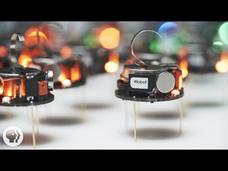Teacher's Pet
Mitosis and Cytokinesis
Be careful when discussing mitosis, it's a divisive issue. The video explains the mitosis and cytokinesis portions of the cell cycle. It discusses the prophase, metaphase, anaphase, and telophase in detail.
Teacher's Pet
DNA Replication
It takes about 800 hours to replicate an average-sized human chromosome of single linear DNA. The video introduces the concept of DNA replication. It briefly explains the concepts of leading strands and lagging strands.
Teacher's Pet
DNA Structure
DNA carries the code for all living organisms, yet it is made up of only four building blocks. The video explains the structure of DNA down to the nucleotides. It provides the relationships between thymine, cytosine, adenine, and guanine.
Teacher's Pet
Cellular Respiration Steps and Pathways
Cellular respiration takes in food and creates energy in the form of ATP. The video explains both aerobic and anaerobic cellular respiration. Both types begin with glycolysis, which the resource concisely describes.
Teacher's Pet
Photosynthesis Steps and Pathways
When studying photosynthesis, most pupils think of trees and flowers but forget about cacti. The video explains the process of photosynthesis both within a cell and the variations due to the type of plant and climate. It includes a short...
Teacher's Pet
Carbohydrates
What is the difference between simple and complex carbohydrates? The video answers that question and more. It covers monosaccharides, disaccharides, and polysaccharides.
Teacher's Pet
Leaf Structure
Take it or leaf it, the video teaches the structure of leaves. It includes a discussion of stomata and the importance of transpiration. It also explains the role of chloroplasts.
Teacher's Pet
Active Transport
Active transport uses energy in the form of ATP. The video explains three types of active transport. It begins with membrane pumps before discussing endocytosis and exocytosis.
Teacher's Pet
Passive Transport Part 2
Cells require a specific amount of water—too much or too little causes problems. The video explains how cells handle having extra or not enough water. It includes plasmolysis, cytolysis, and facilitated diffusion.
Teacher's Pet
Unique Features of Plant Cells
In plants, vacuoles take up most of the space in a cell. The video explains what vacuoles are and their importance. It also discusses the function of the cell wall and plastids, both unique features of plant cells.
Teacher's Pet
Parts of the Eukaryotic Cell
Lipids found in your body include oils, fats, and hormones. The video discusses lipids and their importance to your body, wax, and vitamins. Then, it identifies and explains the job of each part of eukaryotic cells.
Teacher's Pet
Cell History
While Robert Hooke discovered the cell in 1665, the first cell theory didn't come about until the 1830s. The video explains the discovery of the cell and the scientists involved. It continues to the parts of cell theory and the...
Teacher's Pet
The Metric System
What do Myanmar, Liberia, and the United States have in common? They are the only countries that don't use the metric system. The video introduces the metric system by starting with the prefixes. It finishes by showing how to solve...
Teacher's Pet
Observations and Inferences
Most jokes rely on inference, but what is an inference? The video discusses the meaning of both observation and inference. Then, it compares them and offers multiple examples of the differences.
Teacher's Pet
The Scientific Method
Examples of the scientific method in everyday life include: trial and error problem solving, making a budget, cooking, and designing an advertisement. The video explains the steps of the scientific method and two examples of it in real...
Deep Look
Where Are the Ants Carrying All Those Leaves?
Ants don't eat leaves, they use them for farming. The video focuses on this practice, which ants have done for 60 million years. It explains how they use the leaves to grow fungus and build entire underground cities. They even assign...
Deep Look
These 'Resurrection Plants' Spring Back to Life in Seconds
Without water, mosses dry out and stop photosynthesizing, essentially dying. However, with the first drop of rain, even after 100 years, they instantly come to life and grow. The video explains the benefits of this behavior and what...
Deep Look
Can A Thousand Tiny Swarming Robots Outsmart Nature?
Kilobots, made from only $15 worth of parts, work together to achieve a group goal. The video explains how with a few simple lines of programming, these tiny robots tackle tasks in much the same way animals or cells have for centuries....
Deep Look
Nature's Mood Rings: How Chameleons Really Change Color
Demonstrate how our understanding of chameleons trying to blend in was wrong. An education video explains how scientists now know that chameleons manipulate tiny salt crystals in their skin to change colors.
Deep Look
You're Not Hallucinating. That's Just Squid Skin.
Cephalopods, including squid, use their color-changing skin for both camouflage and communication. A video explains how squid camouflage themselves in the open ocean with nothing else around. It shows how they mimic the interplay of...
Deep Look
Watch Flesh-Eating Beetles Strip Bodies to the Bone
A large beetle colony needs only one or two days to completely clean the bones of small animals. The video focuses on the dermestid beetles' flesh-eating abilities. Museums use these beetles to preserve specimens, leaving the most...
Deep Look
Nature's Scuba Divers: How Beetles Breathe Underwater
Some insects breathe air yet live underwater. The video explains how they carry air with them and the scientific principles behind this ability. It focuses on beetles and surface tension as the concept of nature's scuba divers becomes...
Deep Look
The Sex Lives of Christmas Trees
Coniferous trees produce both male and female pine cones. The video explains the differences, how these trees reproduce, and why it is beneficial. It includes facts about the location, size, and age of pine trees.
Deep Look
The Ladybug Love-In: A Valentine's Special
Ladybugs live alone most of the year but gather together for winter. An informative video explains that this gathering serves two purposes: mating and hibernating.























